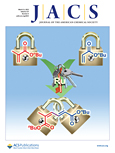 The Journal of the American Chemical Society (JACS) has retracted three articles that had earned expressions of concern by chemistry researchers who were under investigation at the University of Texas, Austin.
The Journal of the American Chemical Society (JACS) has retracted three articles that had earned expressions of concern by chemistry researchers who were under investigation at the University of Texas, Austin.
Kelly Wiggins and Christopher Bielawski have already received two other retractions and several EoCs.
The newly retracted articles have each been cited more than 50 times, according to Thomson Scientific’s Web of Knowledge.
The three papers are:
- Mechanically Facilitated Retro [4 + 2] Cycloadditions
- Mechanical Reconfiguration of Stereoisomers
- Mechanical Activation of Catalysts for C−C Bond Forming and Anionic Polymerization Reactions from a Single Macromolecular Reagent
All three retraction notices (1, 2, 3) say basically the same thing, with different specifics thrown in:
Based on an investigation conducted by The Office of Research Integrity at The University of Texas at Austin, it was determined that the data and scientific conclusions of this article are unreliable as a result of scientific misconduct by one of the co-authors affiliated with the University at the time of its publication. The authors retract this article accordingly.
This makes five retractions, including one from Science, and four remaining expressions of concern for the group.
Hat tip: Kenrod Melrocity
Like Retraction Watch? Consider supporting our growth. You can also follow us on Twitter, like us on Facebook, add us to your RSS reader, and sign up on our homepage for an email every time there’s a new post.
Everything has already pretty much been said about this on previous posts. There is a bit more of a discussion about the topic on ‘In the Pipeline’, but even there it’s dying down.
pipeline.corante.com/archives/2015/03/11/three_more_retractions.php
There is a comment there:
“Interestingly, If you look in the literature, at least one other group has managed to use this chemistry in nanoparticle applications:
http://pubs.acs.org/doi/abs/10.1021/la401990d ”
That is quite interesting and I looked at the paper, but I’m too busy to read it in detail. However, they use the reversal click chemistry from the retracted Science paper, which to me was the most objectionable part of the Wiggins/Bielawski work simply because I didn’t believe in the thermodynamics of it and I said that another bond is more likely to break than an azide to reform from a triazole. However, in this paper from 2013 this retracted chemistry is replicated, albeit not in a polymer, but on nanoparticles. But still, this raises some questions, namely, ‘Is the Wiggins/Bielawski ultimately correct in some way?’ or ‘Is there some funny business in this current paper’ or ‘Is this some unrelated nanoparticle effect or did the authors characterize their chemistry wrong?’ I’ll read it in more detail if I get some free time and don’t get distracted.
To be fair the original C&EN article stated the conclusions of the Science paper were unchanged. While this seems like a pretty common cover-up excuse, perhaps it actually held some water this time?
Actually, I looked at about 3/4 of the article carefully, but I don’t have access to it now unfortunately. They only did two cycles, and it cannot be argued for sure that this is the mechanism operating there. It can very well be that some azides that did not react originally are reacting a second time, especially since they are blocked by the nanoparticle moities and there is no guarantee that 100% react the first time around, so once again the scission phenomenon may not be a reversible Click reaction as is claimed. It’s likely they saw the effect that they did, and assumed it’s this based on previous work by Wiggins and Bielawski, but really, more cycles should have been done, or more careful characterization to prove this for sure.
This thread has come back to life with the comment of ‘Not Clare Francis’ so now I really have to read the other 1/4 of the paper I mentioned in my comment, but I’ll do that in a couple of weeks.
So the nanoparticle group replicated the mechanochemistry results, except those results had been fabricated? Perhaps we have stumbled upon a re-telling of Raymond Jones’ story “Noise Level”.
Paper in Chemical Science retracted by these authors. More detail is given about which data was fabricated, and it seems the misconduct was far worse than I had realized.
http://pubs.rsc.org/en/content/articlelanding/2015/sc/c5sc90019k#!divAbstract
I thought that maybe the science worked as reported, but that the student couldn’t be bothered to go through the time consuming process of collecting a full dataset and maybe added a few extra data points, particularly in the case of that Angewandte article or JACS article Circular dichroism. However, it turns out there was NMR spectra slicing to claim a compound had been made when it hadn’t, a cardinal sin in chemistry (behind tampering with someone else’s reaction). I wonder if the student in question saw the that the path to infamy (established in 2010, at around the time this person’s PhD project started) was easier than the path to fame?
By implication, the retraction of this paper implies that the other RSC articles are viable unless we hear otherwise.
The good thing is that the RSC retraction notice actually tells what was wrong in the Chem. Sci. paper. In fact, analysis of what was wrong implies that 90% of the paper was good, and the wrong things were not fundamentally affecting the rest of the paper; they were limited to a single observation.
However, the Chemical Science paper has nothing to do with the mechanochemistry papers – conceptually. So you cannot draw any conclusions at present from one to the other.
As long as it is no revealed what was fabricated in the other papers, it is not possible to know whether the whole mechanochemistry work of Bielawski is fundamentally sound or fake.
Scientifically this is very unsatisfactory.